Setting Up of an Experimental Site for the Continuous Monitoring of Water Discharge, Suspended Sediment Transport and Groundwater Levels in a Mediterranean Basin. Results of One Year of Activity
Abstract
:1. Introduction
2. Materials and Methods
2.1. Study Area
2.2. Monitoring Equipment and Data Analysis
2.2.1. Water Discharge Measurement
2.2.2. Suspended Sediment Concentration Measurement
2.3. The Groundwater Monitoring Network
- -
- Unit S–Sand and silty sand;
- -
- Unit SC–Silt and clay;
- -
- Unit G–Gravel and sandy-silty gravel;
- -
- Unit C–Clay and silty-clay.
3. Results and Discussion
3.1. Efficiency of the Monitoring Equipment
3.2. Water Discharge–Solid Concentration Patterns
3.3. Hydrogeological and Hydrodynamic Characterization
4. Conclusions
Author Contributions
Funding
Acknowledgments
Conflicts of Interest
Appendix A
The Carapelle Basin and the Selection of the Nested Monitoring Basin
| Area (km2) | 506.2 |
| Perimeter (km) | 141.7 |
| Minimum elevation (m a.s.l.) | 112 |
| Maximum elevation (m a.s.l.) | 1094 |
| Gravelius Index | 1.78 |
| Catchment average slope (%) | 15 |
| Length of main channel (km) | 65.98 |
| Average width of main channel (m) | 9.6 |
| Average slope of main channel (%) | 12.1 |
| Average annual precipitation (mm) | 450÷800 |
| Mean annual temperature (°C) | 10÷16 |
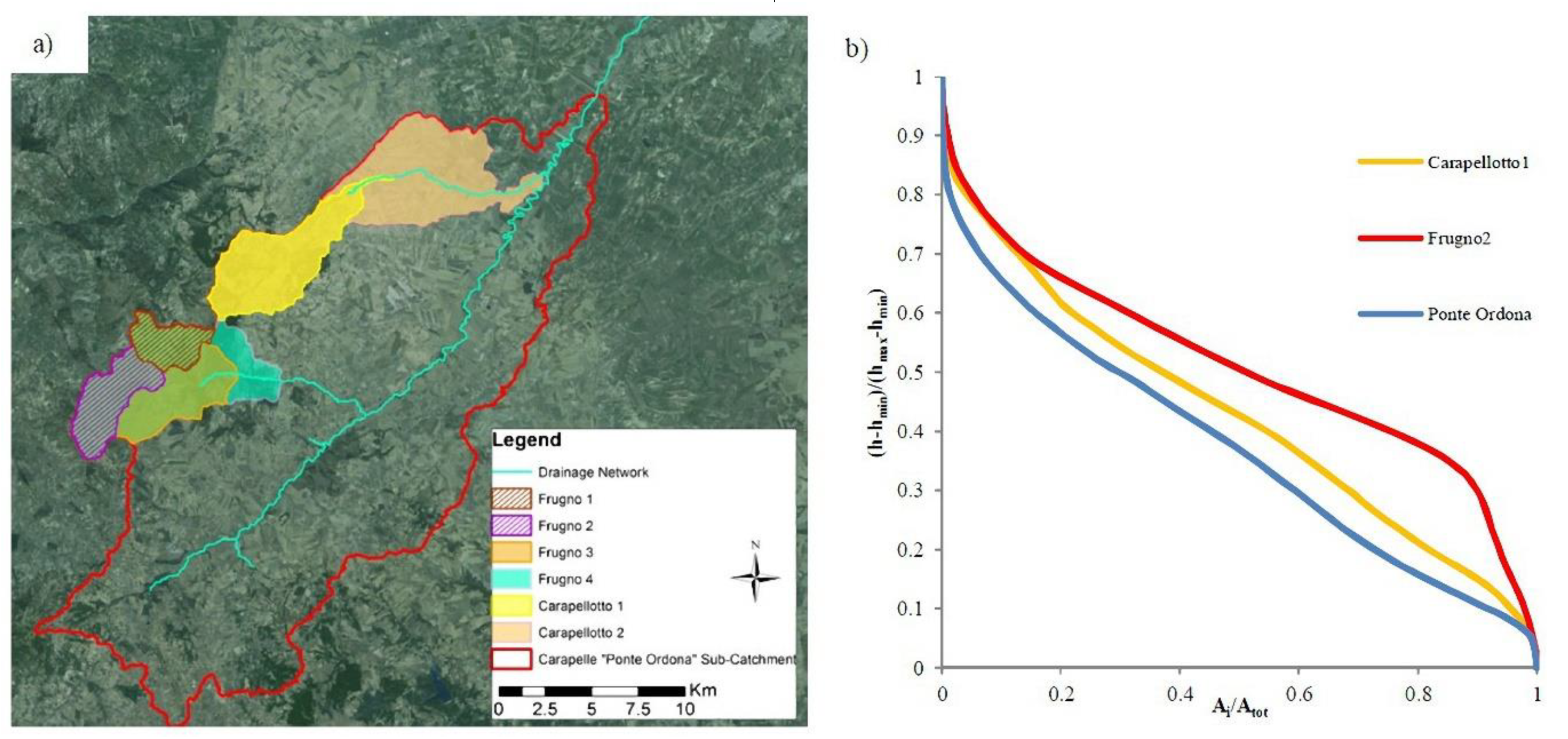
| Basin Name | Area (km2) | Basin Average Slope (%) | Minimum Elevation (m a.s.l.) | Maximum Elevation (m a.s.l.) | Average Elevation (m a.s.l.) | Main Channel Lenght (km) |
|---|---|---|---|---|---|---|
| Carapellotto1 | 27.17 | 19.23 | 226 | 1009 | 548.82 | 16.21 |
| Carapellotto2 | 63.47 | 10.98 | 150 | 1009 | 362.22 | 25.34 |
| Frugno1 | 8.59 | 27.46 | 523 | 1094 | 768.33 | 4.99 |
| Frugno2 | 13.45 | 21.13 | 558 | 1015 | 784.21 | 8.45 |
| Frugno3 | 38.39 | 23.94 | 422 | 1094 | 720.94 | 15.74 |
| Frugno4 | 46.88 | 24.71 | 361.00 | 1094.00 | 697 | 18.85 |
References
- De Boer, D.H.; Campbell, I.A. Spatial scale dependence of sediment dynamics in a semi-arid badland drainage basin. Catena 1989, 16, 277–290. [Google Scholar] [CrossRef]
- Seeger, M.; Errea, M.P.; Beguería, S.; Arnáez, J.; Martí, C.; García-Ruiz, J.M. Catchment soil moisture and rainfall characteristics as determinant factors for discharge/suspended sediment hysteretic loops in a small headwater catchment in the Spanish pyrenees. J. Hydrol. 2004, 288, 299–311. [Google Scholar] [CrossRef] [Green Version]
- Soler, M.; Latron, J.; Gallart, F. Relationships between suspended sediment concentrations and discharge in two small research basins in a mountainous Mediterranean area (Vallcebre, Eastern Pyrenees). Geomorphology 2008, 98, 143–152. [Google Scholar] [CrossRef]
- Luetzenburg, G.; Bittner, M.J.; Calsamiglia, A.; Renschler, C.S.; Estrany, J.; Poeppl, R. Climate and land use change effects on soil erosion in two small agricultural catchment systems Fugnitz–Austria, Can Revull–Spain. Sci. Total Environ. 2020, 704, 135389. [Google Scholar] [CrossRef]
- Vogel, R.M.; Stedinger, J.R.; Hooper, R.P. Discharge indices for water quality loads. Water Resour. Res. 2003, 39. [Google Scholar] [CrossRef] [Green Version]
- Steiger, J.; Gurnell, A.M.; Petts, G.E. Sediment deposition along the channel margins of a reach of the middle River Severn, UK. Regul. Rivers Res. Manag. 2001, 17, 443–460. [Google Scholar] [CrossRef]
- Gentile, F.; Bisantino, T.; Trisorio Liuzzi, G. Erosion and sediment transport modelling in Northern Puglia watersheds. In Proceedings of the WIT Transactions on Engineering Sciences; WIT Press: Southampton, UK, 2010; Volume 67, pp. 199–212. [Google Scholar]
- López-Tarazón, J.A.; Batalla, R.J.; Vericat, D.; Francke, T. The sediment budget of a highly dynamic mesoscale catchment: The River Isábena. Geomorphology 2012, 138, 15–28. [Google Scholar] [CrossRef]
- Ricci, G.F.; Jeong, J.; De Girolamo, A.M.; Gentile, F. Effectiveness and feasibility of different management practices to reduce soil erosion in an agricultural watershed. Land Use Policy 2020, 90, 104306. [Google Scholar] [CrossRef]
- Walling, D.E.; Fang, D. Recent trends in the suspended sediment loads of the world’s rivers. Glob. Planet. Chang. 2003, 39, 111–126. [Google Scholar] [CrossRef]
- De Girolamo, A.M.; Di Pillo, R.; Lo Porto, A.; Todisco, M.T.; Barca, E. Identifying a reliable method for estimating suspended sediment load in a temporary river system. Catena 2018, 165, 442–453. [Google Scholar] [CrossRef]
- Downing, J. Twenty-five years with OBS sensors: The good, the bad, and the ugly. Cont. Shelf Res. 2006, 26, 2299–2318. [Google Scholar] [CrossRef]
- Bhamjee, R.; Lindsay, J.B. Ephemeral stream sensor design using state loggers. Hydrol. Earth Syst. Sci. 2011, 15, 1009–1021. [Google Scholar] [CrossRef] [Green Version]
- Brasington, J.; Richards, K. Turbidity and suspended sediment dynamics in small catchments in the Nepal Middle Hills. Hydrol. Process. 2000, 14, 2559–2574. [Google Scholar] [CrossRef]
- Zabaleta, A.; Martínez, M.; Uriarte, J.A.; Antigüedad, I. Factors controlling suspended sediment yield during runoff events in small headwater catchments of the Basque Country. Catena 2007, 71, 179–190. [Google Scholar] [CrossRef]
- Smith, H.G.; Dragovich, D. Interpreting sediment delivery processes using suspended sediment-discharge hysteresis patterns from nested upland catchments, south-eastern Australia. Hydrol. Process. 2009, 23, 2415–2426. [Google Scholar] [CrossRef]
- Gentile, F.; Bisantino, T.; Corbino, R.; Milillo, F.; Romano, G.; Trisorio Liuzzi, G. Monitoring and analysis of suspended sediment transport dynamics in the Carapelle torrent (Southern Italy). Catena 2010, 80, 1–8. [Google Scholar] [CrossRef]
- García-Rama, A.; Pagano, S.G.; Gentile, F.; Lenzi, M.A. Suspended sediment transport analysis in two Italian instrumented catchments. J. Mt. Sci. 2016, 13, 957–970. [Google Scholar] [CrossRef]
- Klein, M. Anti clockwise hysteresis in suspended sediment concentration during individual storms: Holbeck catchment; Yorkshire, England. Catena 1984, 11, 251–257. [Google Scholar] [CrossRef]
- Jansson, M.B. Determining sediment source areas in a tropical river basin, Costa Rica. Catena 2002, 47, 63–84. [Google Scholar] [CrossRef]
- De Girolamo, A.M.; Pappagallo, G.; Lo Porto, A. Temporal variability of suspended sediment transport and rating curves in a Mediterranean river basin: The Celone (SE Italy). Catena 2015, 128, 135–143. [Google Scholar] [CrossRef]
- Eder, A.; Exner-Kittridge, M.; Strauss, P.; Blöschl, G. Re-suspension of bed sediment in a small stream-results from two flushing experiments. Hydrol. Earth Syst. Sci. 2014, 18, 1043–1052. [Google Scholar] [CrossRef] [Green Version]
- Williams, G. Sediment concentration versus water discharge during single hydrologic events in rivers. J. Hydrol. 1989, 111, 89–106. [Google Scholar] [CrossRef]
- Navratil, O.; Esteves, M.; Legout, C.; Gratiot, N.; Nemery, J.; Willmore, S.; Grangeon, T. Global uncertainty analysis of suspended sediment monitoring using turbidimeter in a small mountainous river catchment. J. Hydrol. 2011, 398, 246–259. [Google Scholar] [CrossRef]
- Fortesa, J.; Ricci, G.F.; García-Comendador, J.; Gentile, F.; Estrany, J.; Sauquet, E.; Datry, T.; De Girolamo, A.M. Analysing hydrological and sediment transport regime in two Mediterranean intermittent rivers. Catena 2020, 196, 104865. [Google Scholar] [CrossRef]
- Gippel, C.J. Potential of turbidity monitoring for measuring the transport of suspended solids in streams. Hydrol. Process. 1995, 9, 83–97. [Google Scholar] [CrossRef]
- Mathys, N.; Brochot, S.; Meunier, M.; Richard, D. Erosion quantification in the small marly experimental catchments of Draix (Alpes de Haute Provence, France). Calibration of the ETC rainfall-runoff-erosion model. Catena 2003, 50, 527–548. [Google Scholar] [CrossRef]
- Orwin, J.F.; Smart, C.C. An inexpensive turbidimeter for monitoring suspended sediment. Geomorphology 2005, 68, 3–15. [Google Scholar] [CrossRef]
- Mano, V.; Nemery, J.; Belleudy, P.; Poirel, A. Assessment of suspended sediment transport in four alpine watersheds (France): Influence of the climatic regime. Hydrol. Process. 2009, 23, 777–792. [Google Scholar] [CrossRef]
- Felix, D.; Albayrak, I.; Boes, R.M. Field measurements of suspended sediment using several methods. In Proceedings of the E-Proceedings 36th IAHR World Congress, Hague, The Netherlands, 28 June–3 July 2015. [Google Scholar]
- García-Comendador, J.; Fortesa, J.; Calsamiglia, A.; Calvo-Cases, A.; Estrany, J. Post-fire hydrological response and suspended sediment transport of a terraced Mediterranean catchment. Earth Surf. Process. Landforms 2017, 42, 2254–2265. [Google Scholar] [CrossRef]
- Winter, T.C.; Harvey, J.W.; Lehn Franke, O.; Alley, M.W. Ground Water and Surface Water: A Single Resource. Available online: https://www.researchgate.net/publication/243787829_Ground_water_and_surface_water_a_single_resource_U (accessed on 7 October 2020).
- Woessner, W.W. Stream and fluvial plain ground water interactions: Rescaling hydrogeologic thought. Ground Water 2000, 38, 423–429. [Google Scholar] [CrossRef]
- Brodie, R.; Sundaram, B.; Tottenham, R.; Hostetler, S.; Ransley, T. An Overview of Tools for Assessing Groundwater-Surface Water Connectivity; Australian Government, Bureau of Rural Sciences: Canberra, Australia, 2007. [Google Scholar]
- Squillace, P.J. Observed and Simulated Movement of Bank-Storage Water. Ground Water 1996, 34, 121–134. [Google Scholar] [CrossRef]
- Siergieiev, D.; Ehlert, L.; Reimann, T.; Lundberg, A.; Liedl, R. Modelling hyporheic processes for regulated rivers under transient hydrological and hydrogeological conditions. Hydrol. Earth Syst. Sci. 2015, 19, 329–340. [Google Scholar] [CrossRef] [Green Version]
- Kattan, Z.; Gac, J.Y.; Probst, J.L. Suspended sediment load and mechanical erosion in the Senegal Basin-Estimation of the surface runoff concentration and relative contributions of channel and slope erosion. J. Hydrol. 1987, 92, 59–76. [Google Scholar] [CrossRef]
- Andermann, C.; Bonnet, S.; Crave, A.; Davy, P.; Longuevergne, L.; Gloaguen, R. Sediment transfer and the hydrological cycle of Himalayan rivers in Nepal. Comptes Rendus-Geosci. 2012, 344, 627–635. [Google Scholar] [CrossRef]
- Ayes Rivera, I.; Callau Poduje, A.C.; Molina-Carpio, J.; Ayala, J.M.; Armijos Cardenas, E.; Espinoza-Villar, R.; Espinoza, J.C.; Gutierrez-Cori, O.; Filizola, N. On the Relationship between Suspended Sediment Concentration, Rainfall Variability and Groundwater: An Empirical and Probabilistic Analysis for the Andean Beni River, Bolivia (2003–2016). Water 2019, 11, 2497. [Google Scholar] [CrossRef] [Green Version]
- Estrany, J.; Garcia, C.; Batalla, R.J. Groundwater control on the suspended sediment load in the Na Borges River, Mallorca, Spain. Geomorphology 2009, 106, 292–303. [Google Scholar] [CrossRef]
- McCallum, J.L.; Cook, P.G.; Berhane, D.; Rumpf, C.; McMahon, G.A. Quantifying groundwater flows to streams using differential flow gaugings and water chemistry. J. Hydrol. 2012, 416–417, 118–132. [Google Scholar] [CrossRef]
- Yang, Z.; Zhou, Y.; Wenninger, J.; Uhlenbrook, S. Une approche pluridisciplinaire pour quantifier les interactions eau superficielle-eau souterraine dans le bassin semi-aride de la rivière Hailiutu, Nord-Ouest de la Chine. Hydrogeol. J. 2014, 22, 527–541. [Google Scholar] [CrossRef]
- Gao, F.; Feng, G.; Han, M.; Dash, P.; Jenkins, J.; Liu, C. Assessment of Surface Water Resources in the Big Sunflower River Watershed Using Coupled SWAT–MODFLOW Model. Water 2019, 11, 528. [Google Scholar] [CrossRef] [Green Version]
- Fattorelli, S.; Lenzi, M.; Marchi, L.; Keller, H.M. Une station expérimentale pour l’enregistrement automatique du débit de l’eau et du transport de sédiments dans un petit bassin versant alpin. Hydrol. Sci. J. 1988, 33, 607–617. [Google Scholar] [CrossRef] [Green Version]
- Fortesa, J.; García-Comendador, J.; Calsamiglia, A.; López-Tarazón, J.A.; Latron, J.; Alorda, B.; Estrany, J. Comparison of stage/discharge rating curves derived from different recording systems: Consequences for streamflow data and water management in a Mediterranean island. Sci. Total Environ. 2019, 665, 968–981. [Google Scholar] [CrossRef]
- Han, K.; Zhang, D.; Bo, J.; Zhang, Z. Hydrological Monitoring System Design and Implementation Based on IOT. Phys. Procedia 2012, 33, 449–454. [Google Scholar] [CrossRef] [Green Version]
- Aquilino, M.; Novelli, A.; Tarantino, E.; Iacobellis, V.; Gentile, F. Evaluating the potential of GeoEye data in retrieving LAI at watershed scale. In Proceedings of the Remote Sensing for Agriculture, Ecosystems, and Hydrology XVI; Neale, C.M.U., Maltese, A., Eds.; SPIE: Bellingham, WA, USA, 2014; Volume 9239, p. 92392B. [Google Scholar]
- Passarella, G.; Barca, E.; Sollitto, D.; Masciale, R.; Bruno, D.E. Cross-Calibration of Two Independent Groundwater Balance Models and Evaluation of Unknown Terms: The Case of the Shallow Aquifer of BTavoliere di Puglia^ (South Italy). Water Resour. Manag. 2016, 31, 327–340. [Google Scholar] [CrossRef]
- Bisantino, T.; Gentile, F.; Milella, P.; Liuzzi, G.T. Effect of Time Scale on the Performance of Different Sediment Transport Formulas in a Semiarid Region. J. Hydraul. Eng. 2010, 136, 56–61. [Google Scholar] [CrossRef]
- Abdelwahab, O.M.M.; Bingner, R.L.; Milillo, F.; Gentile, F. Evaluation of Alternative Management Practices with the AnnAGNPS Model in the Carapelle Watershed. Soil Sci. 2016, 181, 293–305. [Google Scholar] [CrossRef]
- Pagano, S.G.; Rainato, R.; García-Rama, A.; Gentile, F.; Lenzi, M.A. Analysis of suspended sediment dynamics at event scale: Comparison between a mediterranean and an alpine basin. Hydrol. Sci. J. 2019, 64, 948–961. [Google Scholar] [CrossRef]
- Edwards, T.K.; Douglas, G.G. Field Methods for Measurement of Fluvial Sediment. [Rev.] ed., Techniques for Water-Resources Investigations of the United States Geological Survey; U.S. Geological Survey, Techniques of Water-Resources Investigations: Denver, CO, USA, 1999. [Google Scholar]
- Gentile, F.; Bisantino, T.; Corbino, R.; Milillo, F.; Romano, G.; Trisorio Liuzzi, G. Sediment transport monitoring in a Northern Puglia watershed. In Proceedings of the WIT Transactions on Engineering Sciences; WIT Press: Southampton, UK, 2008; Volume 60, pp. 153–161. [Google Scholar]
- Navratil, O.; Legout, C.; Gateuille, D.; Esteves, M.; Liebault, F. Assessment of intermediate fine sediment storage in a braided river reach (southern French Prealps). Hydrol. Process. 2010, 24, 1318–1332. [Google Scholar] [CrossRef]
- Milliman, J.D.; Syvitski, J.P.M. Geomorphic/tectonic control of sediment discharge to the ocean: The importance of small mountainous rivers. J. Geol. 1992, 100, 525–544. [Google Scholar] [CrossRef]
- Hicks, D.M.; Gomez, B.; Trustrum, N.A. Erosion thresholds and suspended sediment yields, Waipaoa River Basin, New Zealand. Water Resour. Res. 2000, 36, 1129–1142. [Google Scholar] [CrossRef]
- Meybeck, M.; Laroche, L.; Dürr, H.; Syvitski, J.P. Global variability of daily total suspended solids and their fluxes in rivers. Glob. Planet. Chang. 2003, 39, 65–93. [Google Scholar] [CrossRef]
- Aich, V.; Zimmermann, A.; Elsenbeer, H. Quantification and interpretation of suspended-sediment discharge hysteresis patterns: How much data do we need? Catena 2014, 122, 120–129. [Google Scholar] [CrossRef]
- Turowski, J.M.; Rickenmann, D.; Dadson, S.J. The partitioning of the total sediment load of a river into suspended load and bedload: A review of empirical data. Sedimentology 2010, 57, 1126–1146. [Google Scholar] [CrossRef]
- McDonough, O.T.; Hosen, J.; Palmer, M. Temporary streams: The hydrology, geography, and ecology of non-perennially flowing waters. River Ecosyst. Dyn. Manag. Conserv. 2011, 7, 259–290. [Google Scholar]
- Song, J.; Zhang, G.; Wang, W.; Liu, Q.; Jiang, W.; Guo, W.; Tang, B.; Bai, H.; Dou, X. Variability in the vertical hyporheic water exchange affected by hydraulic conductivity and river morphology at a natural confluent meander bend. Hydrol. Process. 2017, 31, 3407–3420. [Google Scholar] [CrossRef]
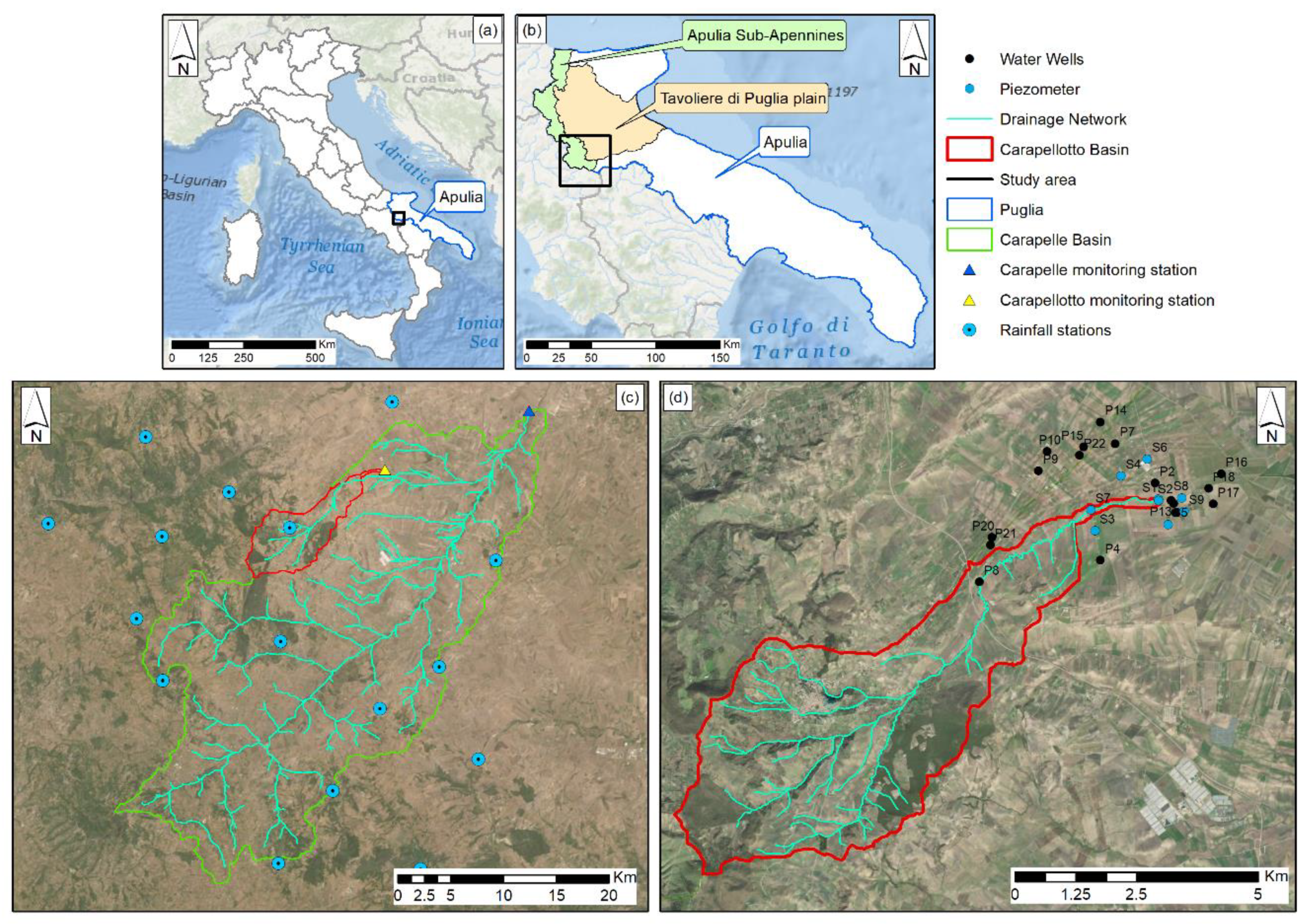
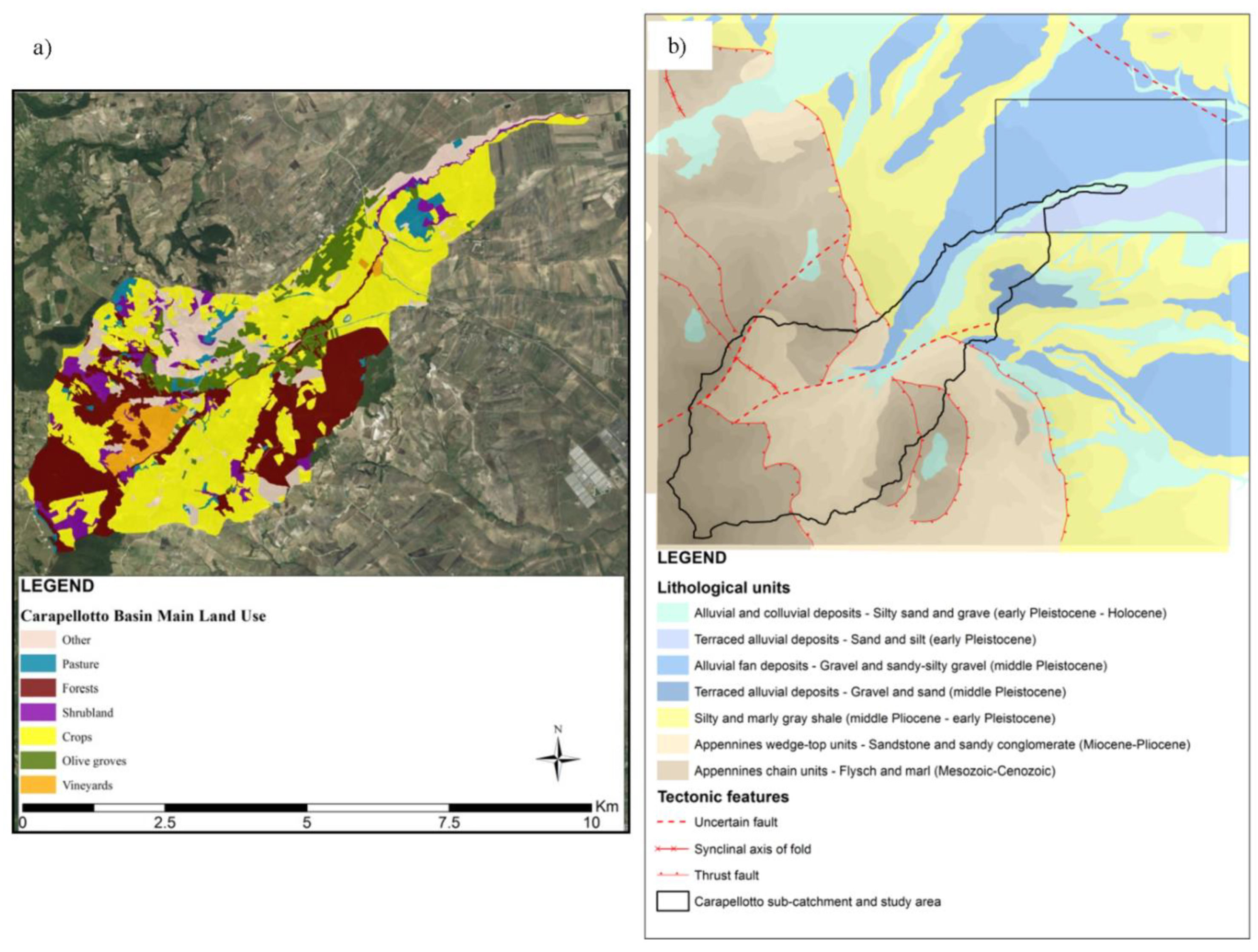
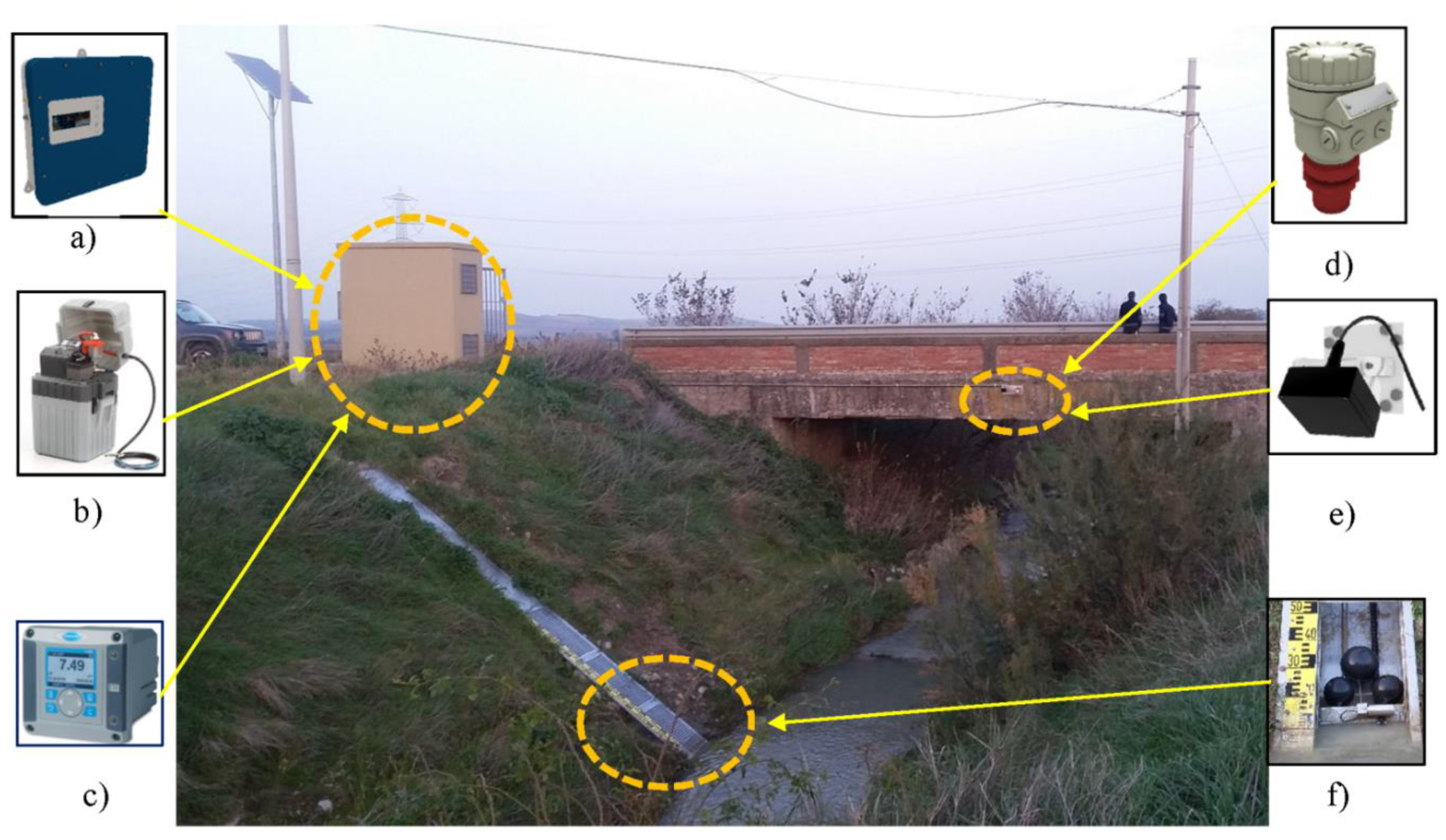
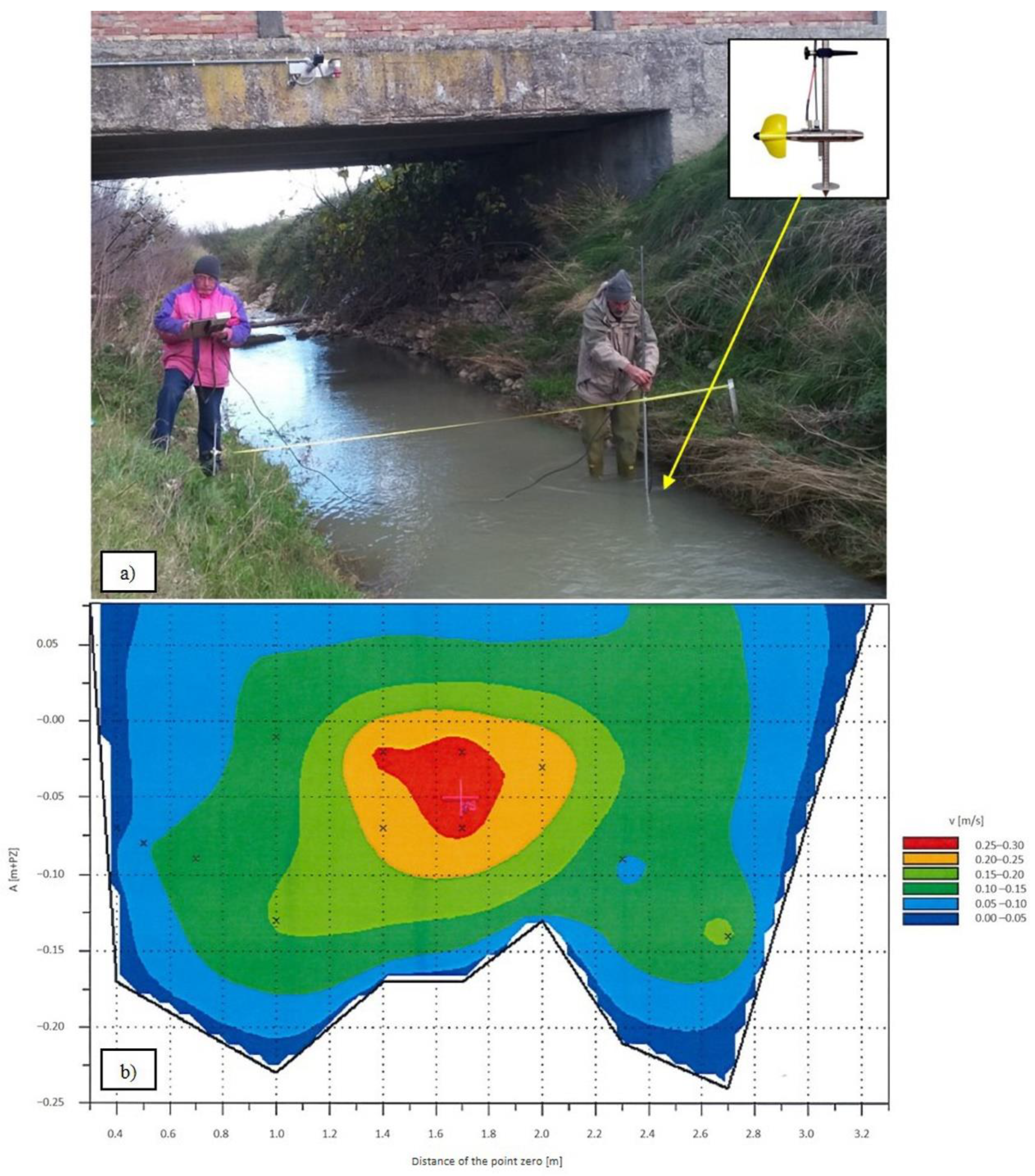
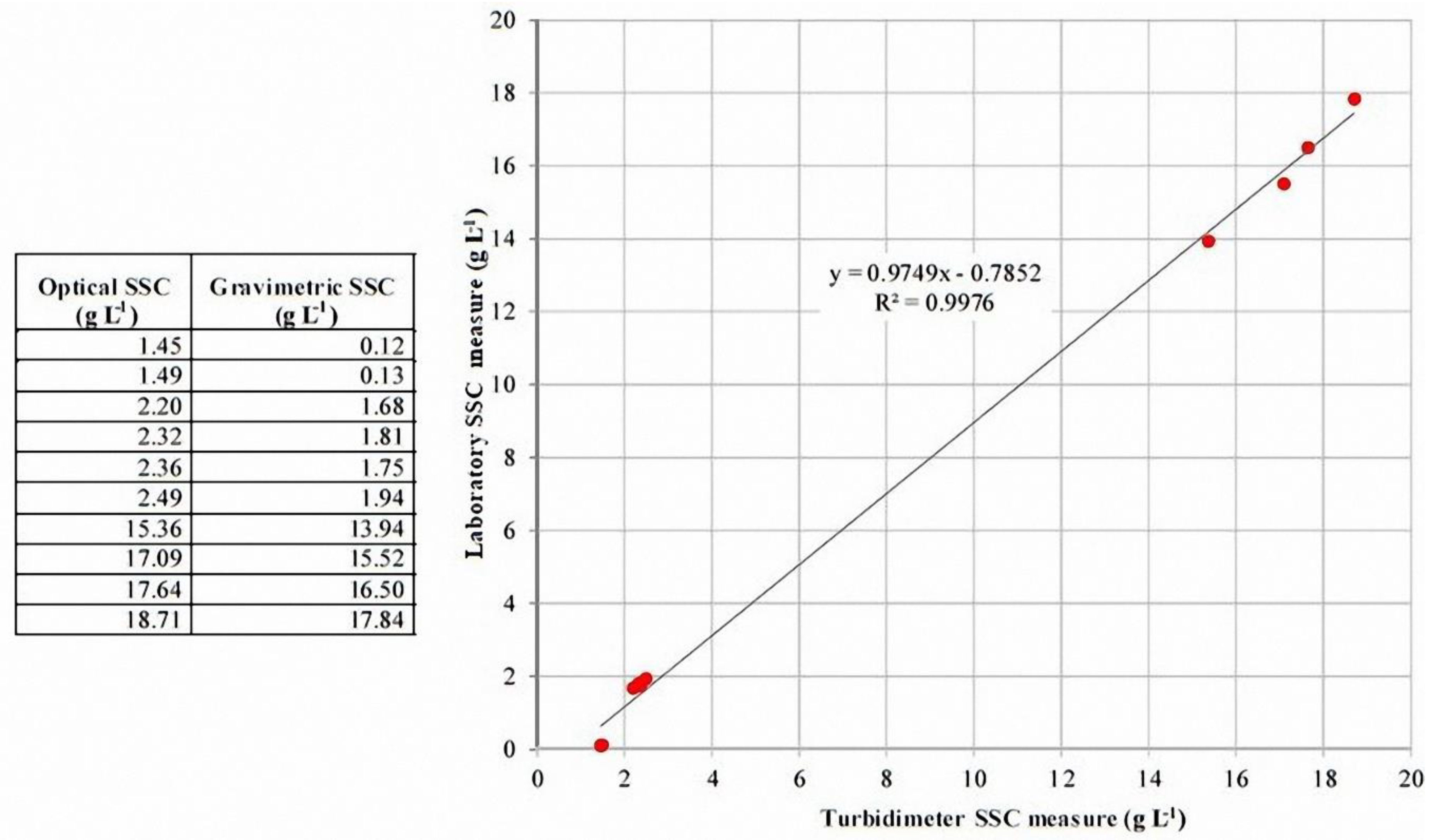

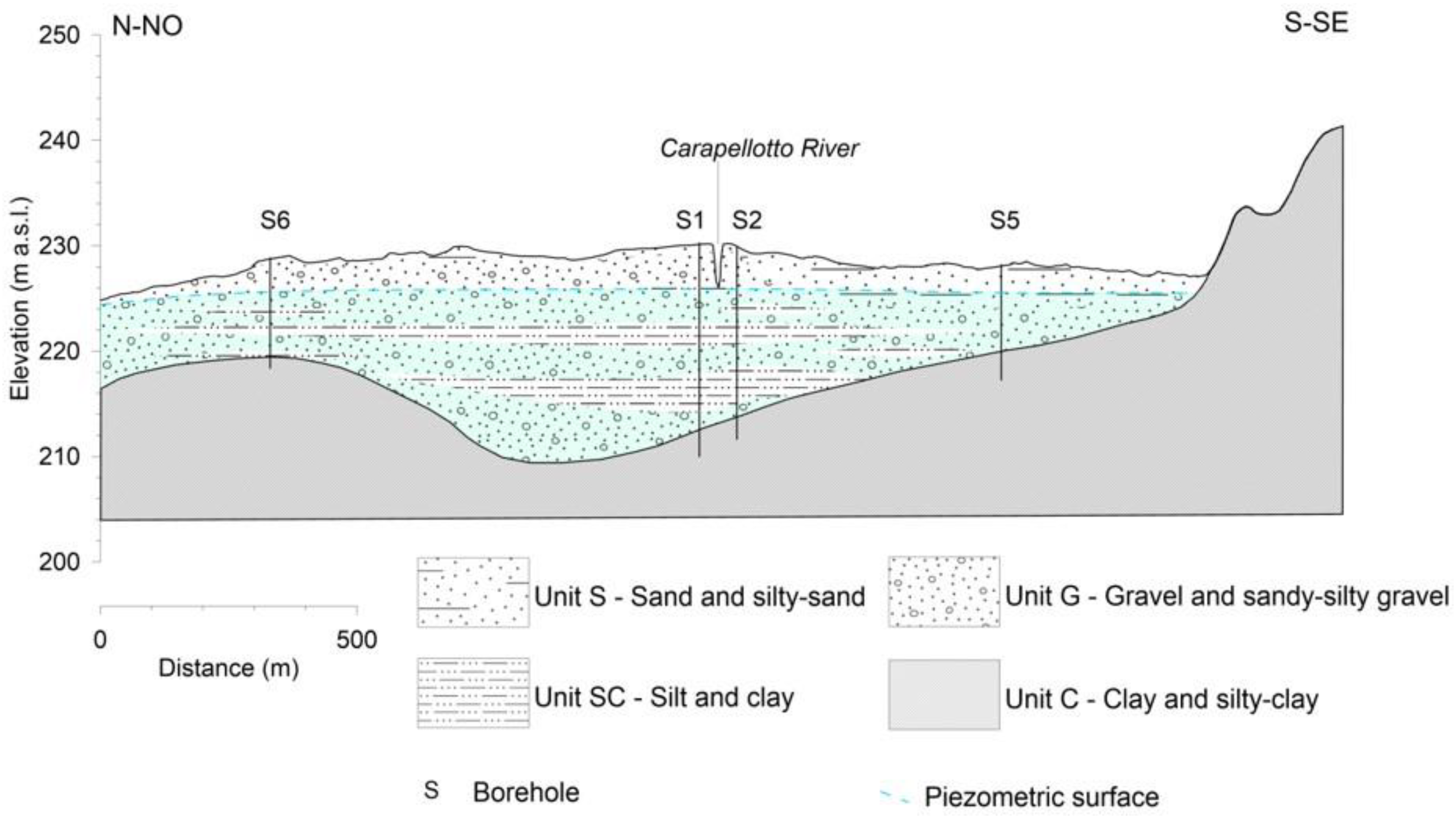

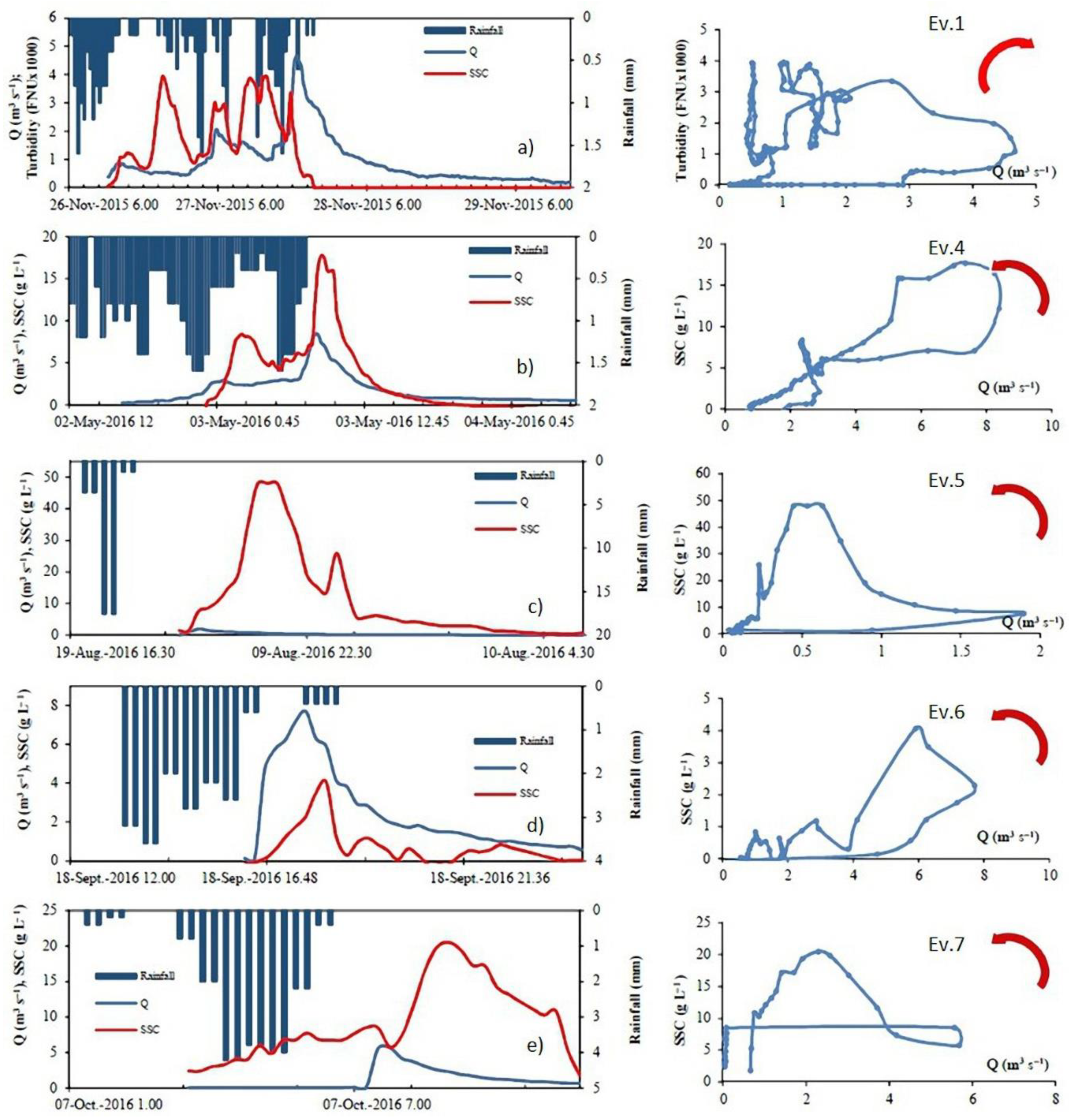
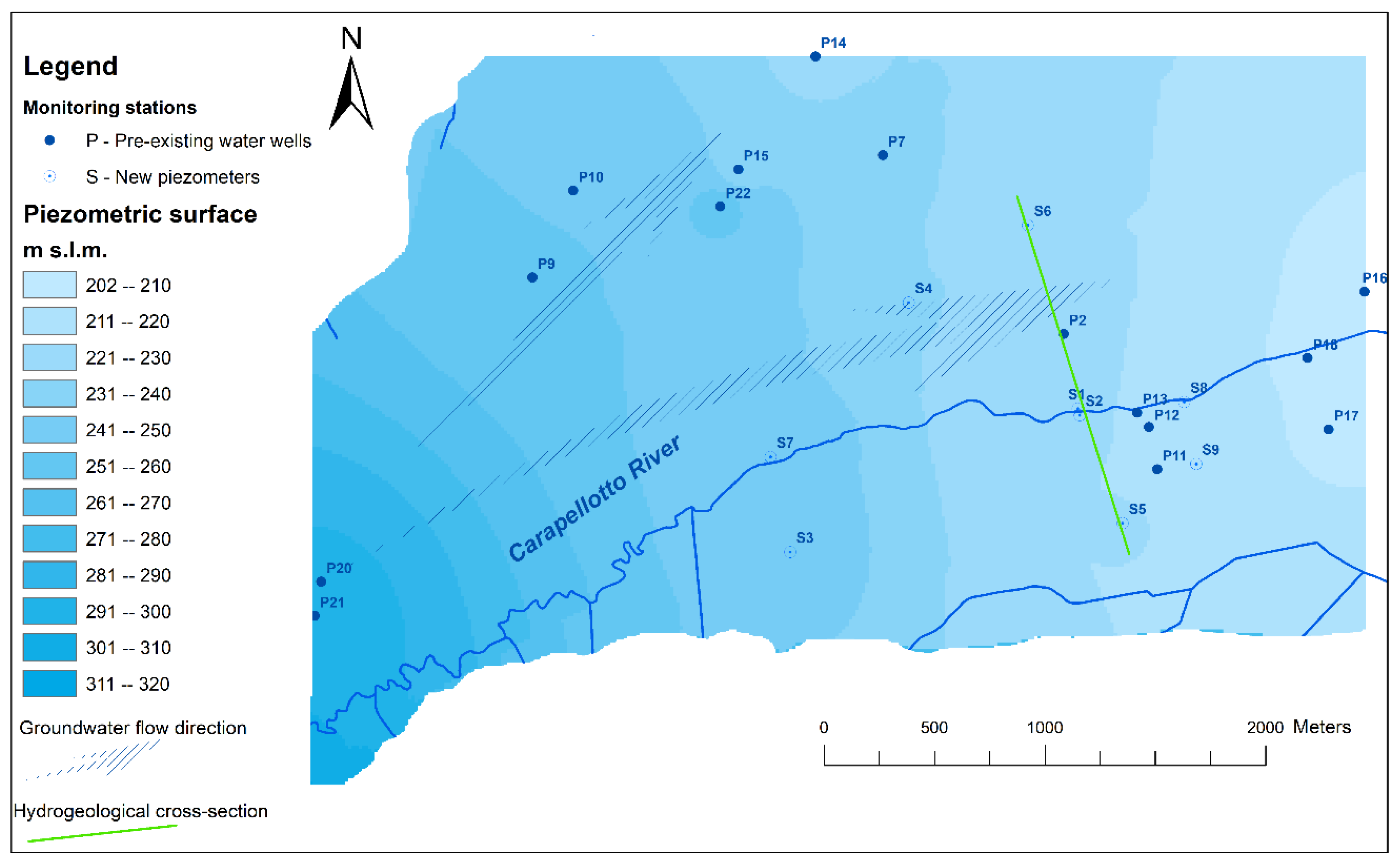
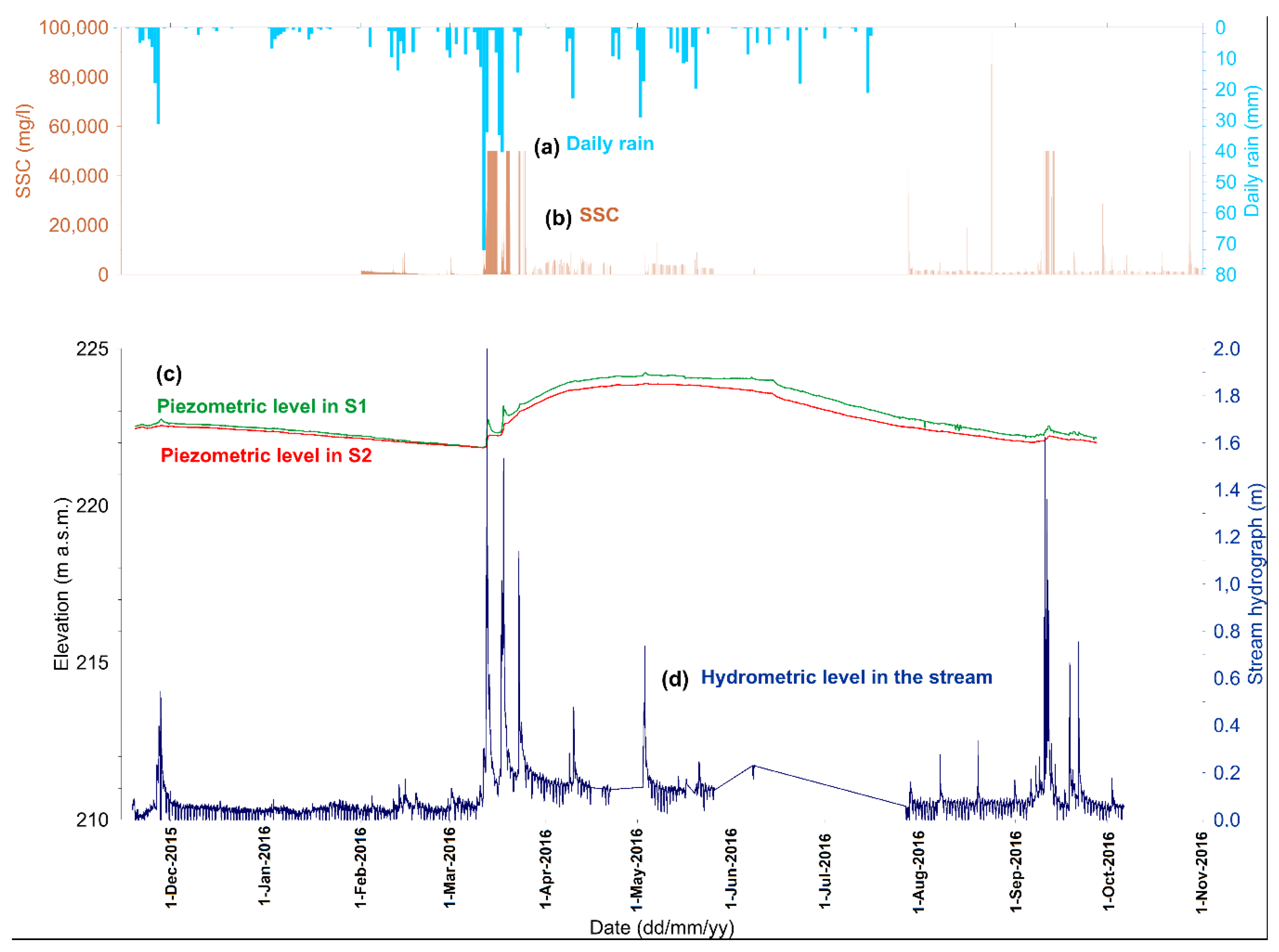

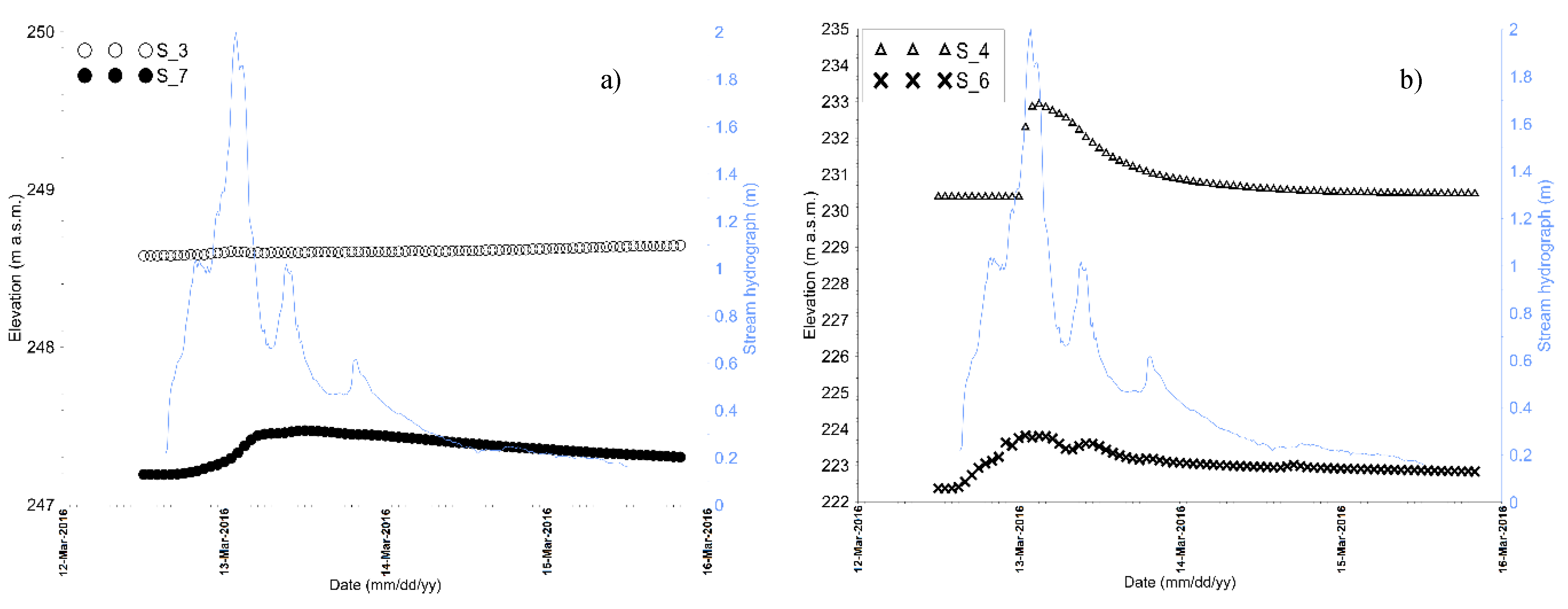
| Area (km2) | 27.17 |
| Perimeter (km) | 31.6 |
| Minimum elevation (m a.s.l.) | 226 |
| Maximum elevation (m a.s.l.) | 1009 |
| Average elevation (m a.s.l.) | 548.82 |
| Gravelius Index | 1.71 |
| Basin average slope (%) | 19.23 |
| Length of the main channel (km) | 16.21 |
| Event nr. | Date | Qp (m3s−1) | SSCp (g L−1) | ∆t (Hours) | Hysteresis Direction | Hysteresis Shape |
|---|---|---|---|---|---|---|
| 1 | 27 November 2015 | 4.66 | 3950 (FNU) | −5.00 | Clockwise | Eight-shaped |
| 2 | 13 March 2016 | 66.53 | - | - | - | - |
| 3 | 23 March 2016 | 19.18 | - | - | - | - |
| 4 | 3 May 2016 | 8.42 | 17.74 | 0.50 | Counter-Clockwise | Eight-shaped |
| 5 | 19 August 2016 | 1.89 | 47.99 | 1.50 | Counter-Clockwise | Circular |
| 6 | 18 September 2016 | 7.70 | 4.06 | 0.75 | Counter-Clockwise | Circular |
| 7 | 7 October 2016 | 5.68 | 20.51 | 1.25 | Counter-Clockwise | Eight-shaped |
| 8 | 27 October 2016 | 5.21 | 47.99 | 3.75 | Counter-Clockwise | Eight-shaped |
| 9 | 8 November 2016 | 2.19 | 8.97 | 2.25 | Counter-Clockwise | Circular |
| 10 | 9 November 2016 | 5.06 | - | - | - | - |
| 11 | 12 November 2016 | 11.36 | - | - | - | - |
Publisher’s Note: MDPI stays neutral with regard to jurisdictional claims in published maps and institutional affiliations. |
© 2020 by the authors. Licensee MDPI, Basel, Switzerland. This article is an open access article distributed under the terms and conditions of the Creative Commons Attribution (CC BY) license (http://creativecommons.org/licenses/by/4.0/).
Share and Cite
Pagano, S.G.; Sollitto, D.; Colucci, M.; Prato, D.; Milillo, F.; Ricci, G.F.; Gentile, F. Setting Up of an Experimental Site for the Continuous Monitoring of Water Discharge, Suspended Sediment Transport and Groundwater Levels in a Mediterranean Basin. Results of One Year of Activity. Water 2020, 12, 3130. https://doi.org/10.3390/w12113130
Pagano SG, Sollitto D, Colucci M, Prato D, Milillo F, Ricci GF, Gentile F. Setting Up of an Experimental Site for the Continuous Monitoring of Water Discharge, Suspended Sediment Transport and Groundwater Levels in a Mediterranean Basin. Results of One Year of Activity. Water. 2020; 12(11):3130. https://doi.org/10.3390/w12113130
Chicago/Turabian StylePagano, Stefano Giorgio, Donato Sollitto, Marco Colucci, Davide Prato, Fabio Milillo, Giovanni Francesco Ricci, and Francesco Gentile. 2020. "Setting Up of an Experimental Site for the Continuous Monitoring of Water Discharge, Suspended Sediment Transport and Groundwater Levels in a Mediterranean Basin. Results of One Year of Activity" Water 12, no. 11: 3130. https://doi.org/10.3390/w12113130
APA StylePagano, S. G., Sollitto, D., Colucci, M., Prato, D., Milillo, F., Ricci, G. F., & Gentile, F. (2020). Setting Up of an Experimental Site for the Continuous Monitoring of Water Discharge, Suspended Sediment Transport and Groundwater Levels in a Mediterranean Basin. Results of One Year of Activity. Water, 12(11), 3130. https://doi.org/10.3390/w12113130






